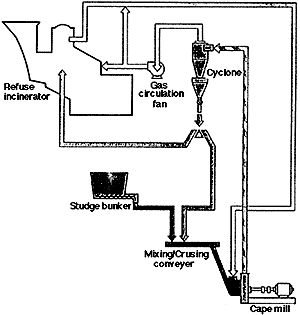Waste Treatment Technology in JAPAN
Drying, Incineration and Melting
A large amount of incineration heat is wasted by refuse incineration. Accordingly, utilizing this excess heat from the refuse incinerator for drying and incinerating sludge is being noticed as an effective energy saving policy. 50 to 100 lit. per ton of supplementary fuel for the refuse incinerator can be economized.
Quickly noticing this "Refuse / Sludge Co-firing System", TAKUMA is making a number of achievements with this co-firing type which is appropriate for varying conditions.
Fig.1 Sludge Co-firing system wite flush dry system
For example :
Since a large coefficient of heat transfer capacity can be obtained, apparatus becomes compact and suitable for large scale equipment.
- Highly Economical
[Introduction ]
Debris expelled by cities can be divided into two large groupings. One is sewage and the other is refuse. At present, reclamation of sludge generated from sewage processing is done after volume reducing incineration. However, since there is 65 to 85 % water content remaining even after dewatering the sludge, a huge amount of supplementary fuel is needed for incineration.
[System flow]
The flowchart of the system is shown below for flush dry system as an example, see Fig.l.

Sludge Co-firing system wite flush dry system
The sludge is crushed and agitated and then dried by coming in contact with
about 400 deg.C exhaust gas at the cage mill. After that, it is separated, recovered and fed into the incinerator.
TAKUMA Sludge Co-firing system
[Characteristics]
Supplementary fuel for sludge incineration is unnecessary which allows power consumption and thus low cost operation.
- Labor Saving
Automation of equipment as well as effective operation with a few personal is possible.
- Equipment is Compact
Refuse incinerator has shared parts which are more compact and cost less construct than individual equipment.
- Effective in Accordance with Environmental Pollution Control
Refuse incinerator and total system affords an environmental control al more thorough management possible.
[Actual results]
TAKUMA has installed 10 sludge co-firing systems in Japan.